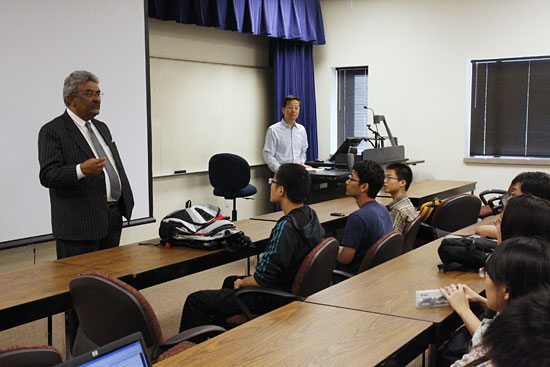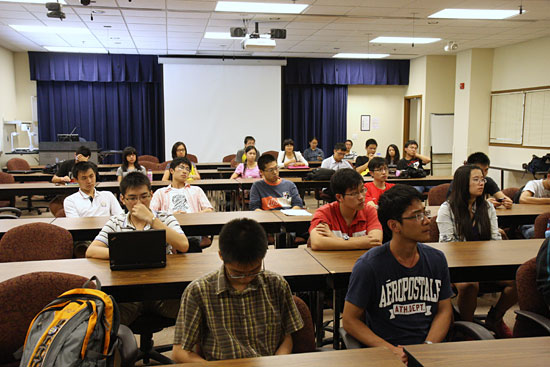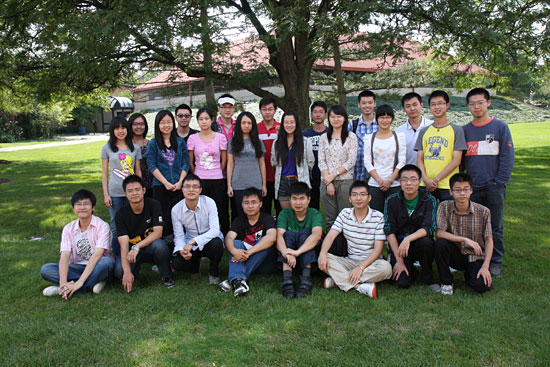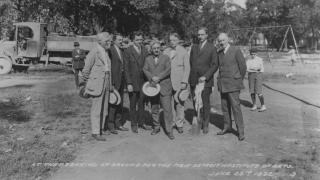
College of Engineering and Computer Science Dean Subrata Sengupta (left) talks to the group of Chinese students who are studying at UM-Dearborn this fall.
_________________________________________________________________________________
The arithmetic problem 3+2 sounds pretty simple, but at University of Michigan-Dearborn, it adds up to a lot more than five.
The numbers represent two of the latest programs in longstanding joint partnerships between UM-Dearborn and two top-rated Chinese universities: Huazhong University of Science and Technology (HUST) in Wuhan and Xi’an Jiaotong University (XJTU) in Shaanxi.
A nearly 10-year relationship between these universities has been extended. The new programs are virtually identical, and consist of an undergraduate student exchange program and what is known as a “3+2” program.
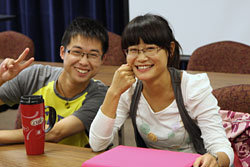 For the undergraduate student exchange program, qualified students from HUST and XJTU will be allowed to register as guest students in CECS for up to two semesters. UM-Dearborn will provide limited tuition scholarships to these students, and credits they earn will transfer back to HUST and XJTU.
For the undergraduate student exchange program, qualified students from HUST and XJTU will be allowed to register as guest students in CECS for up to two semesters. UM-Dearborn will provide limited tuition scholarships to these students, and credits they earn will transfer back to HUST and XJTU.
The 3+2 program will admit qualified HUST and XJTU seniors (with three years of study at their home universities) to CECS for two more years at UM-Dearborn. These students will receive bachelor’s degrees from HUST or XJTU and master’s degrees from UM-Dearborn. Limited tuition scholarship will also be provided for these students.
“I want to emphasize that the HUST and XJTU students who come here are among the best students from China,” says Yubao Chen, director of China Programs and professor of IMSE.
The HUST and XJTU students arrived this fall. Meanwhile, six undergraduate and five graduate HUST students came to UM-Dearborn in 2010 on a different visiting program and are doing well academically and socially.
“The past seven months studying at UM-Dearborn has been one of the greatest experiences of my life,” says Tuo Xiang, a visiting HUST senior. “By joining the college’s Intelligent Systems Club, I have been able to design a navigation system for a robot. Prof. Zhao, who coordinates the HUST program, has helped me with all kinds of issues that visiting students run into. Prof. Natarajan, my senior design adviser, has spent many weekends teaching me what I need to know.”
“I’ve also met a lot of great American friends here who help me learn the culture and lifestyle. It’s all been like an adventure.”
The China-Dearborn academic exchange dates back to the early 1990s. Many XJTU and HUST visiting scholars, graduate students, and post-doctoral fellows have come to Dearborn to work with CECS faculty. These esteemed visiting scholars and students have made tremendous contributions to CECS research programs, according to Yi Lu Murphey, professor and chair of electrical and computer engineering.
“This is a great higher education model for the future, especially in these more technical fields,” says Murphey. “The personal exchanges are powerful enough. But the exchange of professional and technical ideas and information multiplies the value of both.”
“It’s a great partnership,” agrees Chen. “Certainly, it benefits the students and their home universities in China. But the addition of these top students to southeastern Michigan is a benefit for the Detroit/Dearborn area. It brings intellectual capital and also helps the economy.”
The benefits go both ways, of course. Many XJTU and HUST visiting scholars and postdoctoral fellows have returned to China and have become academic leaders and university administrators.
HUST is located in Wuhan, a historical and industrial city in central China. At present, it has about 19,000 graduate students and 37,000 undergraduate students. Most students are enrolled in engineering, technology, science, medicine, and architectural design courses.
XJTU is a comprehensive research university offering programs in science, engineering, medicine, economics, management, art, law, philosophy, and education. Its major emphasis is on science and engineering. There are 30,000 full-time students and 13,000 master’s and doctoral candidates.
Article reprinted from Dearborn Engineer magazine.

